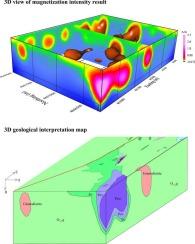基于高精度磁测的岩浆型镍铜硫化物矿床构造分析——以东天山白心滩镍铜矿床为例
IF 3.6
2区 地球科学
Q1 GEOLOGY
引用次数: 0
摘要
白心滩矿床是中国东天山镍带新近发现的岩浆型镍铜硫化物矿床之一。随着勘探的深入,对该区地下整体构造和未暴露矿床的认识还不足以应对深部勘探的挑战。在本研究中,主要由于铁磁性矿物的频繁存在,采用了成本效益高、精度高的地磁测量方法来调查矿区的地下结构。利用高精度磁数据,利用水平导数、倾斜角度和解析信号等鲁棒边缘检测器圈定主要断层结构。利用三维物性反演技术,确定了原生矿化带的延伸范围和含矿岩体的埋藏深度。根据现有的地质和钻探信息,确定了找矿目标区。研究结果表明,研究区主要磁异常为浅层地质体,特别是深度小于400 m的地质体,其形态与地表裸露的基性-超基性岩石吻合较好。主要磁构造方向为NE- sw和NW-SE,其中NE向与成矿密切相关。含基性-超基性镍铜成矿岩沿ne向断裂向东延伸。该研究不仅加强了百心滩矿区的矿产勘查工作,而且对寻找戈壁沙漠覆盖的类似矿床具有重要的参考价值。本文章由计算机程序翻译,如有差异,请以英文原文为准。

Structural analysis of magmatic Ni-Cu sulfide deposit based on high-precision magnetic surveying: A case study of the Baixintan Ni-Cu deposit in eastern Tianshan, NW China
The Baixintan deposit is one of newly discovered magmatic Ni-Cu sulfide deposit in eastern Tianshan nickel belts, NW China. As exploration progresses, the understanding of the whole subsurface structure and unexposed deposits in this area remains insufficient to meet the challenges of deep exploration. In this study, a cost-effective and high-precision ground magnetic surveying was employed to investigate the underground structures of the mining area, primarily due to the frequent presence of ferromagnetic minerals. Utilizing the high-precision magnetic data, the main fault structures were delineated based on robust edge detectors such as horizontal derivative, tilt angle and analytic signal. Additionally, the extensions of the primary mineralization zones and the burial depths of the ore-bearing rock bodies were determined through 3D physical property inversion technology. The target area for ore exploration was defined based on the available geological and drilling information. Our findings suggest that the primary magnetic anomalies in the study area are attributed to shallow geological bodies, specifically those less than 400 m in depth, and their morphology agrees well with the mafic–ultramafic rocks exposed on the surface. The predominant magnetic structures are oriented in the NE-SW and NW-SE directions, of which the NE direction is closely related to mineralization. The Ni-Cu mineralization bearing mafic–ultramafic rocks extends eastward along the NE-trending fault. This study not only enhances mineral exploration efforts in the Baixintan mining area but also serves as a valuable reference for exploring similar deposits covered by the Gobi Desert.
求助全文
通过发布文献求助,成功后即可免费获取论文全文。
去求助
来源期刊

Ore Geology Reviews
地学-地质学
CiteScore
6.50
自引率
27.30%
发文量
546
审稿时长
22.9 weeks
期刊介绍:
Ore Geology Reviews aims to familiarize all earth scientists with recent advances in a number of interconnected disciplines related to the study of, and search for, ore deposits. The reviews range from brief to longer contributions, but the journal preferentially publishes manuscripts that fill the niche between the commonly shorter journal articles and the comprehensive book coverages, and thus has a special appeal to many authors and readers.
 求助内容:
求助内容: 应助结果提醒方式:
应助结果提醒方式:


